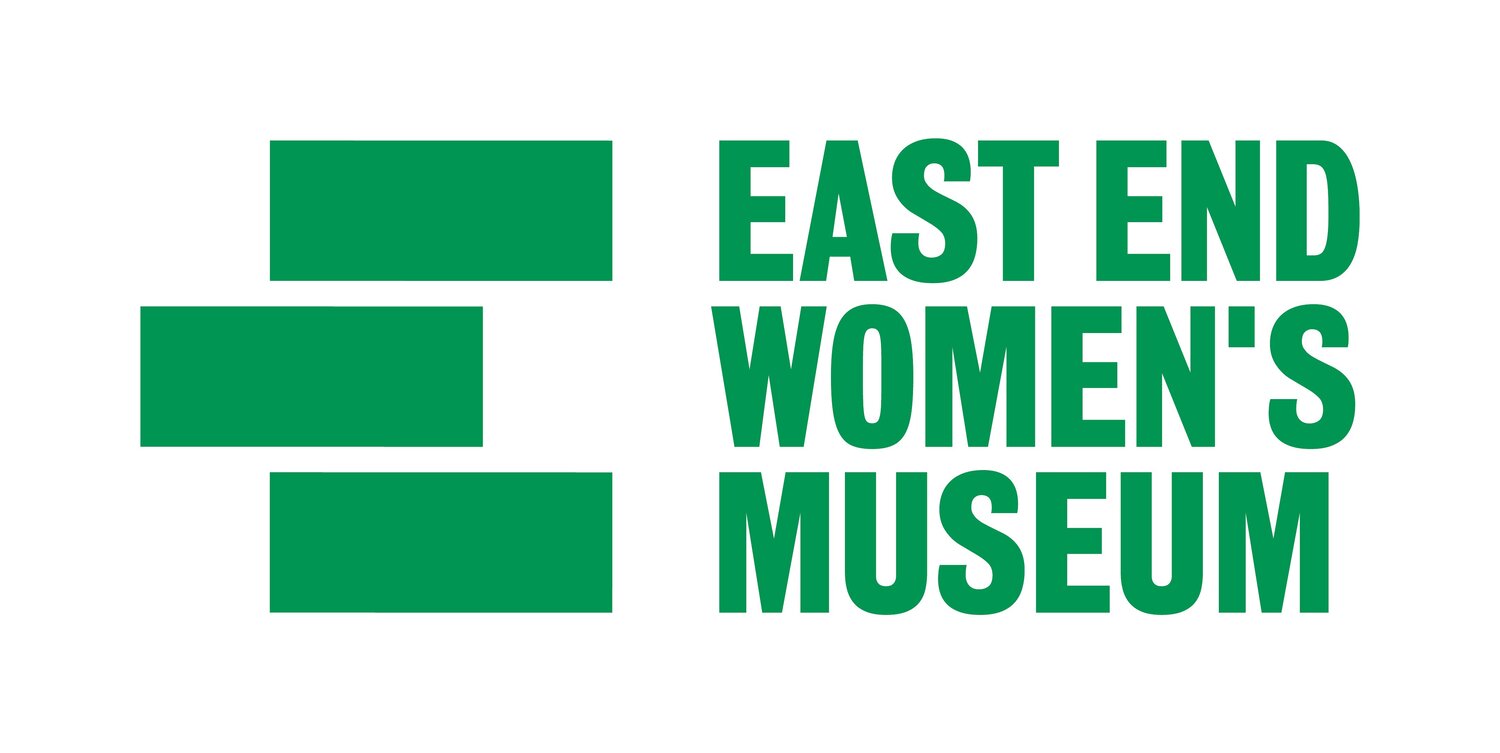Tucked away on a substation in Hermit Road Recreation Ground, Canning Town stood a surprising mural. It was a vibrant memorial to a remarkable local woman, Daisy Parsons, who was elected the Mayor of West Ham in 1936, the first woman to ever do so. The mural suggests the highlights of her mayoral career were opening the Beckton Lido and driving the first West Ham trolley bus. However, Daisy Parsons story involved much more than her year as Mayor; she was on the frontlines of the suffragette cause in the East End and she worked for the good of her local community throughout her life. I will endeavour to chronicle her story, as the substation the mural was on was knocked down earlier this year: a reminder of how easily local history can be lost.
Daisy Parsons mural at Hermit Road Recreation Ground, now destroyed. (c) Newham History Society (June 2008)
Daisy Parsons was born Marguerite Lena Millo in Poplar, East London in 1890. Her parents moved when she was young to Canning Town, which was part of the parish of West Ham at that time. While she enjoyed school, she had to leave education at 12 years old to look after her younger brothers and earn some money doing chores for her neighbours. At 14 she started working as a maid and after a few years she sought out better paid work at the Carreras Tobacco Company in Aldgate. Working in a factory made her realise a new injustice; men were given higher wages for the same work. Her male co-workers were also given a fixed lunch hour and a place to eat, whereas the women, if they got a lunch break, had to eat it in the lavatory. Daisy saw how the power of collective action had been able to change the lives of working men:
“We know that if the men were working under these conditions, through their trade unions, and through their votes they would say they would not tolerate that sort of thing.”
Fittingly, Daisy married a keen trade unionist Tom (Robert Stanley) Parsons at Congregational Chapel, Barking Road in 1908. They went on to have three daughters, including a niece they took care of, and one son.
At this time the political climate of the East End was changing dramatically, marked by the opening of the first London branch of the Women's Social and Political Union in Canning Town in 1906. The WSPU had started in Manchester but suffragette leader Sylvia Pankhurst recognised the need to make working women’s voices a central part of the movement and sought them out in the East End of London. In contrast, her mother and sister, Emmeline and Christabel Pankhurst believed they should seek the support of the wealthy and influential upper classes. Eventually due to the conflict within the WSPU the East London Federation of the Suffragettes was founded in 1914, creating its own newspaper The Woman’s Dreadnought.
It was one of the founders of the Canning Town branch, Minnie Baldock, who encouraged and mentored Daisy Parsons. When the South West Ham branch of the ELFS formed, Daisy became the Secretary. The Woman’s Dreadnought gives us evidence of Daisy Parsons involvement in the movement, from her reports of sales of the newspaper to her accounts of brutality at marches.
“At last the mounted police came up at a gallop and drove everyone away. Mrs Parsons was driven off in the crowd down Birdcage Walk. She saw a young woman dressed in pink with a jeering crowd behind her. The young woman stopped and stood with her back against the wall. A sentry walked up to her and pushed her. She said ‘How dare you!’, and he struck her in the face with his fist.” - The Woman’s Dreadnought (May 30th 1914)
According to one source Daisy carried a ‘life preserver’ to marches, hidden in her sleeve. It was a length of rope knotted at one end, that could be used as a weapon if she had to defend herself, although she reportedly never had to use it. The women of ELFS knew that they were risking their lives pursuing suffrage, but the poverty of the East End had left them little choice. Their ally Sylvia Pankhurst went on hunger strike in 1914 to force the Prime Minister to hear their case for the vote.
The 1914 Deputation, Daisy Parsons stands on the far right.
Prime Minister Asquith eventually relented and allowed six East End women, including Daisy Parsons to visit him at 10 Downing Street. Sylvia Pankhurst was not able to attend as she had not yet recovered from the effects of her hunger strike. During the meeting with the Prime Minister, the women spoke of the hardship they had endured in their lives due to the unjust system that gave them no political voice. Daisy Parsons used her speech to argue particularly for parental rights for mothers which she had fought for with her own children.
“I feel if we women are able to perform the high duty of motherhood – and after all there are mothers who have brought statesmen into the world, because they have all had mothers, and we bring sailors, policemen and everybody into the world – we should at least have a say as to how those children should be brought up.”
The First World War began in August 1914 and it only entrenched the poverty of the East End as men left to fight, food prices rose and many people had no money to live on. Daisy Parsons worked tirelessly during this time, visiting local families to report on their living conditions and fundraising for supplies to help them. Daisy was involved in setting up a Mother and Child Welfare Centre in West Ham to help women who were struggling without their husbands as they were lost to war.
In 1918 the Representation of the People Act was passed which allowed women to vote, but only if they were over 30 and owned some property or wealth. Daisy, being only 28 at the time was still not granted suffrage. However, it was the first step to her political career and she was elected Labour Councillor for Beckton ward only four years later in 1922. In 1931 she became Deputy Mayor of West Ham, the first time a woman had taken up the position. She continued as a councillor and in 1935 was elected Alderman. As women were gaining power it was not always met favourably, but Daisy was well up to fighting for her position.
“Alderman Mrs Parsons strode across the chamber and on reaching Alderman Rumsey, struck him with a copy of the Council reports which she had in her hands exclaiming ‘You called me a --------‘ Alderman Rumsey endeavoured to return the blow but several colleagues hastily interposed and prevented the Alderman from rising” - Stratford Express (25th February 1936)
Despite the occasional council altercations, in 1936 Daisy Parsons was elected the Mayor of West Ham. The time for women in politics had truly come as it was Daisy and another woman, Alderman Mrs Bock, up for election as Mayor that year. Sweetly, it was her eldest daughter, who she had spoken of to Prime Minister Asquith years before, that became her Mayoress.
“West Ham has a lady mayor. She is Alderman Daisy Parsons, the first of her sex and the youngest mayor to occupy the mayoral chair. She was elected at the annual meeting of the council on Monday and her eldest daughter Mrs M I Tompkin will fill the role of Mayoress.” - Stratford Express (9th November 1936)
Her election as Mayor was not unanimous however and of course it was her foe in the council, Alderman Rumsey, who commented on this landmark event with disdain:
“This council chamber is deteriorating, and I wish I had got out of it before ever I saw a woman occupying that chair.” - Stratford Express (9th November 1936)
Her year as Mayor was eventful, as the mural of Hermit Road depicted, but soon Daisy Parsons had to face her second World War. As usual she rose to the occasion and was heavily involved in organising the Women's Voluntary Service and the evacuation of local children. In the Newham Archive there is a wonderful note signed by Daisy Parsons on behalf of the Womens Voluntary Service that reads “Will you kindly allow bearer a free bath, as she has been bombed from 52 Gurney Road E.15”. The note serves as testament to her care for local people in such dark times.
After the Second World War Daisy Parsons was recognised for her ongoing dedication to West Ham, and was awarded the Freedom of the Borough in 1949. During the ceremony the Mayor spoke of her legacy:
“Indeed women had to thank her for her fight in the cause of women’s enfranchisement. Those who knew her knew that when she had a job to do she did it conscientiously and did not spare herself.” - Stratford Express (November 1949)
Daisy Parsons was awarded an MBE in the New Year Honours of 1951 and she continues to receive commemoration for her impact on the lives of East End women to this day. Most recently in 2019 a blue plaque was put up outside Stratford Town Hall.
While we honour her political achievements, it is her ability to fight that is so impressive to me. A woman who felt she had to hide a defensive weapon in her sleeve to attend marches for her suffrage. A woman who hit her fellow Alderman with a council report when he insulted her. A woman who thought of others first, even when she was in the same desperate situation as them. So while the local mural at Hermit Road Recreation Ground is lost, Daisy Parsons is still remembered as a central part of the story of West Ham and the liberation of women in the East End.
Author
Katie May Anderson grew up in Newham and is a recent graduate. She is primarily a researcher in dress and textiles but also enjoys studying the history of her local area.
Twitter: @kmacostume.
Sources
Janice Brooker ‘Daisy Parsons the first woman Mayor of West Ham’ (26th August 2003) http://freepages.rootsweb.com/~arrow/genealogy/daisy_parsons.htm
BBC London ‘The east London origins of votes for women’ (8th February 2018) https://www.youtube.com/watch?v=iPFgmkwielA
LSE Digital Library ‘The Woman’s Dreadnought May 30 1914’ https://digital.library.lse.ac.uk/objects/lse:lob213cig
Sarah Jackson ‘How the East London Federation of Suffragettes was born’ (23rd October 2016) https://www.eastlondonsuffragettes.com/blog/how-the-east-london-federation-of-suffragettes-was-born
Many thanks to the Newham History Society which inspired this blog post and supplied the photo of the destroyed Daisy Parsons mural.







